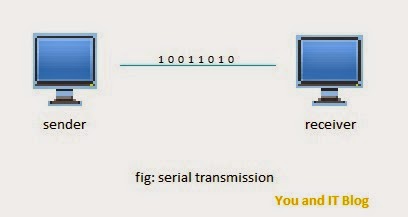Data transmission
Data transmission refers to the transmission of data over
wires no matter this all is happening on the very thin wires embedded on an
electronic chip or these data travel by telephone lines. Basically, there are
two ways for data transmission: serial transmission of data and parallel
transmission of data.
Parallel transmission
In parallel transmission of data, bits are sent through
parallel wires from source to destination in a pinch of time interval. All bits
reach the destination exactly at the same time. If n wires are used then n bits
can be transferred. This technique cost much as n number of wires are needed
and therefore is used for shorter distances (generally not more than a meter).
This technique results in fast transmission of data with same reason of having
n number of wires.
Serial transmission
In serial transmission, all bits travel one after the other
on a single line. It reduces the cost of transmission n times as compared to
parallel transmission, but the speed of transmission is affected. Where
parallel transmission has no any types, serial transmission can be of three
types: asynchronous, synchronous, and isochronous kind of transmission.
Asynchronous transmission
In asynchronous kind of transmission there is no
synchronization between bytes of data i.e. a byte after other do not reach
after regular time gap, every byte takes random amount of time to travel. In
asynchronous transmission bits are still synchronized i.e. every successor bit
follows its predecessor lagging by a definite quantity of time, inside of a
byte (8 bits form one byte). To make receiver predict the arrival of next byte,
a byte is stuffed with a start bit (0) and a stop bit (1); thus each byte is increased
in size to 10 bits. Conclusion: duration between bits are same but between
bytes are different here.
Synchronous transmission
In synchronous kind of transmission bytes are synchronized
i.e. there is no random gap between bytes. Bytes are sent together in the form
of frame. Each byte is of size of 8 bits and there is no need of start and stop
bits. Although the bytes are synchronized, but frames of data again, have
random time gaps between them and they are left unsynchronized.
Isochronous transmission
In isochronous kind of transmission, there exist
synchronization between frames. Each frame has bytes synchronized. And each
byte has bits synchronized. Isochronous transmission is used in real time audio
and videos such as watching any video which is generally made to run at 30
frames per second for better quality, playing games which cannot have frame
count less than 16 fps and runs better at 30 fps thus guaranteeing the arrival
of frames of data at a fixed rate which results in good quality graphics of the
game.



